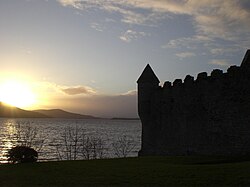Parke's Castle
| Parke's Castle | |
| County Leitrim | |
|---|---|
 Outer bawn of Parke's Castle | |
| Location | |
| Grid reference: | G78263514 |
| Location: | 54°15’53"N, 8°20’4"W |
| History | |
| Built 15th century | |
| Information | |
Parke’s Castle (also known as Newtown Castle and O'Rourke's Castle) is a Plantation-era castle standing on the banks of Lough Gill, in County Leitrim.[1] Originally an earlier fifteenth-century Uí Ruairc (O'Rourke) castle, it came into the possession of Sir Roger Parke, who, by 1628, had completed his fortified manor house at the centre of the older Gaelic castle.
History
O'Rourke's Castle
Excavations in 1972–73 revealed the base of the original O'Rourke tower house beneath the courtyard cobbles, and this is now exposed to view. It was in this tower house that Francisco de Cuellar, the shipwrecked Armada officer, was entertained by Sir Brian O'Rourke. In later years, de Cuellar was to write of his host: "Although this chief is a savage, he is a good Christian and an enemy of the heretics and is always at war with them.” O'Rourke was eventually captured, indicted and executed for high treason in London in 1591.
His son and successor, Brian Oge O'Rourke inherited his title and continued his father's struggle against the English reconquest of these lands. The O'Rourke castle harboured many Irish lords during the Nine Years' War and was also the destination for O'Sullivan Beare's infamous march from the Beara Peninsula in the winter of 1602. Although O'Sullivan arrived, nearly 1,000 of his kingdom's men, women and children had died.
Parke's Castle
During the plantations of Leitrim in the 1610s, Sir Roger Parke, an English captain and planter, inherited the castle and its surrounding estate. Roger's son, Robert, married Roscommon woman Ann Povey, and they had three children; Anne, Robert (b. 1661) and Maggie (b. 1663). The name given to the estate by the Parke family was Newtown Castle, and they made it their permanent residence.
Tragedy befell the Parke family when Maggie and Robert drowned while boating on Lough Gill in 1677, leaving Anne as the sole heiress. Anne married Sir Francis Gore and went to live with him in County Sligo, allowing the castle to fall into disrepair following her parents’ passing. The castle was left deserted for over two centuries and eventually came into state ownership.
Restoration and layout

The castle had extensive and sensitive restoration carried out at the end of the 20th century by the Office of Public Works. The window glazing was reinstated, and local artisans restored the timber stair and the mortise and tenon oak roof, using techniques of the 17th century.
The walls of the original bawn were a spacious pentagonal defensive area, with the O'Rourke tower house placed in the centre of the courtyard. The stones of O’Rourke’s tower were used to build the three-storey manor on the eastern side, eventually adorned with mullioned windows and diamond-shaped chimneys. One of two round flankers guarding the north side of the bawn forms one end of the manor. The other end has the gate building with an arched entrance leading into the enclosure. Inside the courtyard are many stonework buildings and a covered well. There is also a postern gate and a sally port; through there are no flankers on the lakeshore. This may be explained by the likelihood that the water level was ten feet higher in the seventeenth century and would have lapped up against the bawn walls. These waters may have fed the moat that formerly surrounded the bawn.
Location and access
Parke’s Castle is located three miles north-west of Dromahair on the Sligo road (R286) and seven miles from Sligo.
The castle is opened from late March to late September. A small admission fee is charged, granting access to the castle, exhibitions and audio-visual facilities. There is access for visitors with disabilities to the ground floor.[2]
A short distance south-east of Parke's Castle stand the remains of Castle Duroy, another former stronghold of the Ó Ruairc (O'Rourke) clan. The ruins of Castle Duroy sit on a small peninsula which juts out into Lough Gill. Very little of this castle now remains above ground.[1] The site of Castle Duroy is on the northern shore of Lough Gill, just off the main Sligo to Dromahair road (the R286).
Outside links
References
- ↑ 1.0 1.1 Tom Condit, Gabriel Cooney, Claire Foley and Colm Donnelly, Archaeology Ireland Heritage Guide No. 62: Parke's Castle, Co. Leitrim, p. 1–2. Archaeology Ireland, Dublin, 2013.
- ↑ "Parke’s Castle". Heritage Ireland. http://www.heritageireland.ie/en/north-west/parkescastle/. Retrieved 12 Oct 2016.